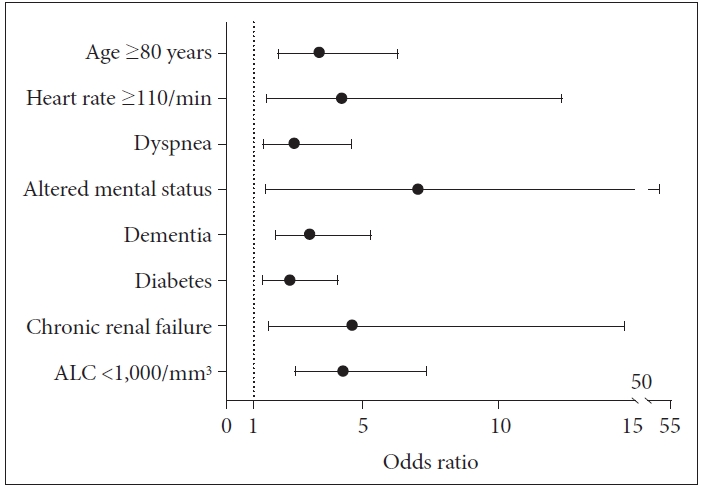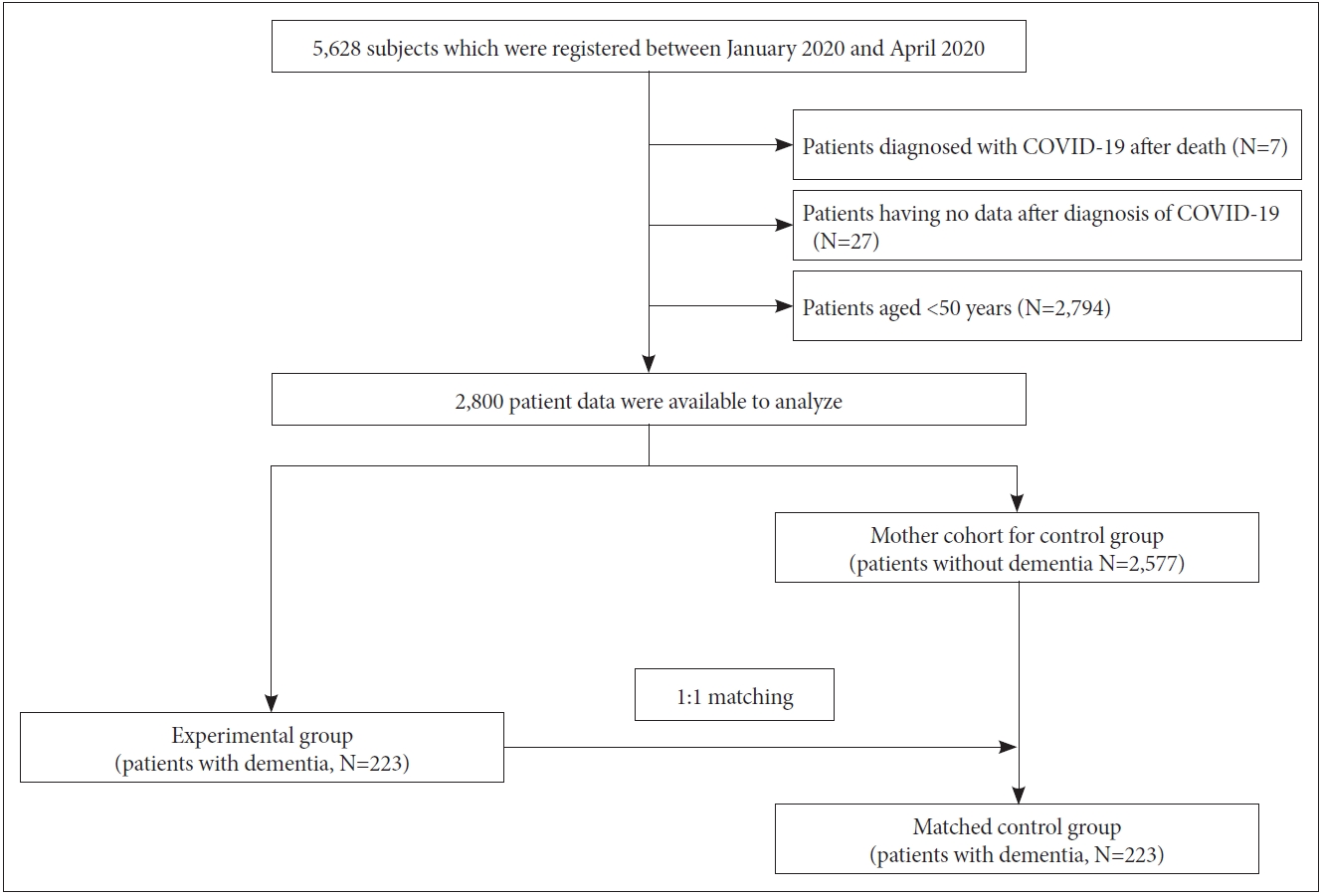 |
 |
- Search
| Psychiatry Investig > Volume 18(6); 2021 > Article |
|
Abstract
Objective
Methods
Results
Supplementary Materials
ACKNOWLEDGEMENTS
The authors have no potential conflicts of interest to disclose.
AuthorsŌĆÖ contribution
Conceptualization: Sheng-Min Wang, Sung-Soo Park. Data curation: See Hyun Park. Formal analysis: See Hyun Park, Sung-Soo Park. Funding acquisition: Sheng-Min Wang. Investigation: Nak-Young Kim, Dong Woo Kang. Methodology: Sheng-Min Wang, See Hyun Park, Sung-Soo Park. Project: Nak-Young Kim, Dong Woo Kang. Administration: Hae-Ran Na, Yoo Hyun Um. Resources: See Hyun Park. Software: See Hyun Park. Supervision: Hyun Kook Lim, Seunghoon Han. Validation: Hae-Ran Na, Yoo Hyun Um. Visualization: Hae-Ran Na, Yoo Hyun Um. WritingŌĆöoriginal draft: Sheng-Min Wang, Sung-Soo Park. WritingŌĆöreview & editing: Sheng-Min Wang, See Hyun Park, Sung-Soo Park, Hyun Kook Lim.
Figure┬Ā2.

Table┬Ā1.
| Variables |
Groups |
p-value | |
|---|---|---|---|
| Dementia (N=223) | No dementia (N=223) | ||
| Age (yr) | 0.949 | ||
| ŌĆā50-59 | 9 (4.0) | 7 (3.1) | |
| ŌĆā60-69 | 22 (9.9) | 21 (9.4) | |
| ŌĆā70-79 | 52 (23.3) | 55 (24.7) | |
| ŌĆāŌēź80 | 140 (62.8) | 140 (62.8) | |
| Gender | 0.272 | ||
| ŌĆāFemale | 153 (68.6) | 141 (63.2) | |
| ŌĆāMale | 70 (31.4) | 82 (36.8) | |
| Systolic blood pressure (mm Hg) | 0.686 | ||
| ŌĆā<120 | 54 (24.2) | 51 (22.9) | |
| ŌĆā120-129 | 36 (16.1) | 26 (11.7) | |
| ŌĆā130-139 | 35 (15.7) | 32 (14.3) | |
| ŌĆā140-159 | 65 (29.1) | 75 (33.6) | |
| ŌĆāŌēź160 | 30 (13.5) | 36 (16.1) | |
| Diastolic blood pressure (mm Hg) | 0.829 | ||
| ŌĆā<80 | 105 (47.1) | 110 (49.3) | |
| ŌĆā80-89 | 67 (30.0) | 59 (26.5) | |
| ŌĆā90-99 | 35 (15.7) | 33 (14.8) | |
| ŌĆāŌēź100 | 13 (5.8) | 18 (8.1) | |
| Heart rate (bests/min) | 80.7┬▒17.5 | 82.3┬▒15.3 | 0.326 |
| Body temperature (┬░C) | 36.8┬▒0.6 | 36.8┬▒0.5 | 0.765 |
| Baseline presentation | |||
| ŌĆāSputum (+) | 27 (12.1) | 33 (14.8) | 0.422 |
| ŌĆāFatigue (+) | 11 (4.9) | 10 (4.5) | 0.592 |
| ŌĆāDyspnea (+) | 37 (16.6) | 43 (19.3) | 0.453 |
| ŌĆāAltered mental status (+) | 8 (3.6) | 4 (1.8) | 0.308 |
| ŌĆāNausea/vomiting (+) | 7 (3.1) | 7 (3.1) | 0.606 |
| ŌĆāDiarrhea (+) | 13 (5.8) | 21 (9.4) | 0.214 |
| Comorbidity | |||
| ŌĆāDiabetes (+) | 63 (28.3) | 69 (30.9) | 0.604 |
| ŌĆāHypertension (+) | 126 (56.5) | 124 (55.6) | 0.924 |
| ŌĆāHeart failure (+) | 12 (5.4) | 14 (6.3) | 0.840 |
| ŌĆāCardiac disease (+) | 15 (6.7) | 20 (9.0) | 0.416 |
| ŌĆāAsthma (+) | 8 (3.6) | 10 (4.5) | 0.810 |
| ŌĆāChronic obstructive lung disease (+) | 8 (3.6) | 6 (2.7) | 0.786 |
| ŌĆāChronic renal disease (+) | 10 (4.5) | 13 (5.8) | 0.668 |
| ŌĆāPrevious malignant disease* (+) | 5 (2.2) | 6 (2.7) | 0.999 |
| ŌĆāChronic hepatic disease (+) | 6 (2.7) | 5 (2.7) | 0.999 |
| ŌĆāAutoimmune disease (+) | 0 (0.0) | 0 (0.0) | |
| Baseline hemogram | |||
| ŌĆāHemoglobin (g/dL) | 12.1┬▒1.9 | 12.1┬▒1.8 | 0.855 |
| ŌĆāWhole blood cell counts (/mm3) | 6,130┬▒2,907 | 6,487┬▒3,169 | 0.216 |
| ŌĆāAbsolute lymphocyte counts (/mm3) | 1,322┬▒691 | 1,336┬▒627 | 0.827 |
| ŌĆāPlatelet (/mm3) | 207,468┬▒80,951 | 215,027┬▒79,296 | 0.320 |
Table┬Ā2.
| Outcomes |
Groups |
p-value | |
|---|---|---|---|
| Dementia (N=223) | No dementia (N=223) | ||
| Death | 75 (33.6) | 45 (20.2) | 0.002ŌĆĀ |
| Days alive from admission to death in those who died | 14.0┬▒11.5 | 15.5┬▒11.9 | 0.483 |
| Days needing hospitalization in those who recovered | 29.6┬▒10.8 | 29.1┬▒120 | 0.714 |
| Requiring oxygen supply* | 117 (52.5) | 102 (45.7) | 0.185 |
| Requiring invasive ventilative support | 76 (34.1) | 49 (22.0) | 0.006ŌĆĀ |
Table┬Ā3.
| Variable | Odd ratio (95% CI) | p-value |
|---|---|---|
| Age (yr) | ||
| ŌĆā<80 | 1 | |
| ŌĆāŌēź80 | 3.40 (1.91-6.28) | <0.001* |
| Heart rate, baseline | ||
| ŌĆā<110/min | 1 | |
| ŌĆāŌēź110/min | 4.22 (1.49-12.32) | 0.007* |
| Dyspnea at presentation | ||
| ŌĆāNot present | 1 | |
| ŌĆāPresent | 2.49 (1.35-4.59) | 0.004* |
| Altered mental status at presentation | ||
| ŌĆāNot present | 1 | |
| ŌĆāPresent | 7.03 (1.45-52.48) | 0.026* |
| Comorbidity | ||
| ŌĆāDementia, no | 1 | |
| ŌĆāDementia, yes | 3.05 (1.80-5.3) | <0.001* |
| ŌĆāDiabetes, no | 1 | |
| ŌĆāDiabetes, yes | 2.32 (1.32-4.1) | 0.004 |
| ŌĆāHypertension, no | 1 | |
| ŌĆāHypertension, yes | 1.13 (0.65-1.96) | 0.675 |
| ŌĆāChronic renal disease, no | 1 | |
| ŌĆāChronic renal disease, yes | 4.62 (1.56-14.61) | 0.007* |
| Hemoglobin at presentation | ||
| ŌĆāŌēź12.5 g/dL | 1 | |
| ŌĆā<12.5 g/dL | 1.63 (0.96-2.81) | 0.073 |
| Absolute lymphocyte counts at presentation | ||
| ŌĆāŌēź1,000 /mm3 | 1 | |
| ŌĆā<1,000 /mm3 | 4.27 (2.53-7.34) | <0.001* |
REFERENCES








